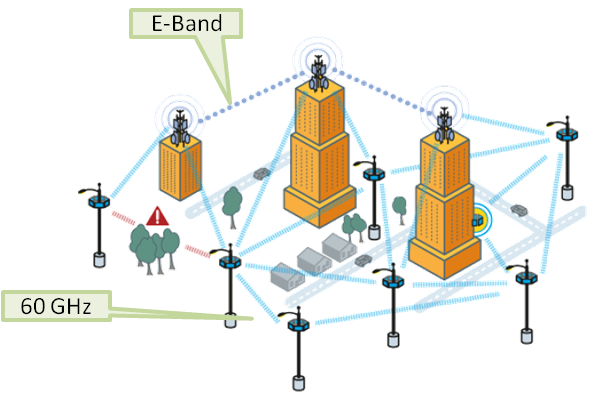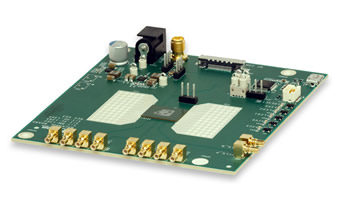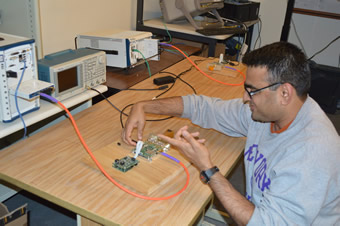Millimetre wave - the enabler for 5G infrastructure
The availability of previously unused high frequency spectrum bands may be the enabling factor in wireless backhaul for the next generation of mobile networks, writes Sally Ward-Foxton.
It’s no secret that the sheer volume of wireless data capacity required by consumers for their digital lifestyles is increasing exponentially. Social media networks consistently auto-play video content these days, and video on-demand has taken off too, but this is only the tip of the iceberg before the IoT fully emerges. The trouble is, there isn’t enough bandwidth available to meet these rapidly growing demands. There is only a certain amount of spectrum to go around in the 4G/LTE bands, and it’s very expensive. Mobile network operators are therefore looking to other parts of the spectrum, and their associated technologies, in order to build the high capacity infrastructure required for 5G.
Enter the 60GHz band. There is a certain amount of spectrum up for grabs (14GHz in the US) which is available in all or most territories, unlicensed and crucially, completely free to use. This band is much higher frequency than the 4G/LTE bands, with wavelengths in the 1 to 10mm range, so it’s often referred to as millimetre wave (mm wave).
The high frequencies mean a high data rate is possible, ideal for transmission of large amounts of data at high speeds. The downside is that the transmission range is very small, partly because of the higher attenuation of high frequency signals by objects like buildings, and partly because there’s an oxygen absorption peak in the middle of the band. Signals can travel a few metres up to a few hundred metres, with line of sight and special antennas. This short range might not be ideal for most purposes, but it suits mobile backhaul because the short ranges mean that frequencies can be reused relatively close by without risk of interference. High gain antennas are typically used to extend the range, which are highly directional, helping prevent signals from being intercepted.
“60GHz is particularly well suited to 5G backhaul in very dense urban deployments of small cells, where the cell radius is expected to move from around 500 to around 100m in order to deliver high capacity to mobile users,” said Mark Barrett, Chief Marketing Officer at Blu Wireless, a Bristol-based company that designs 60GHz baseband IP.
A dynamic network
“[mm wave technology] allows self configuration during installation and the ability to adapt if the beam is blocked by street level obstructions such as buses or trucks. We estimate an order of magnitude cost reduction compared to the current generation of backhaul equipment,” Barrett added. “Making the network dynamically reconfigurable also has the advantages of being able to adapt to varying traffic conditions since the data load can vary rapidly in both up and down link directions.”

Blu Wireless is part of the ‘Bristol is Open’ project - a joint venture between Bristol University and Bristol City Council, which is intended to provide 1Gbit/s coverage to areas of the city that aren’t served directly by fibre (see figure 1 - above). A fibre optic cable will be connected to wireless hotspots on lamp posts and other street furniture, enabled by Blu Wireless’s Lightning 60GHz modules. These hotspots will offer data rates up to 1Gbit/s for the purposes of the test.
“We have delivered 40 of our first generation Lightning 60GHz modems,” Barrett commented. “Of these, nine have been installed in Bristol City Centre and we have demonstrated reliable operation of 1Gbit/s data rates at over 200m. The Bristol is Open project is developing its core operating system and when this is complete, the full network will be commissioned.”
The Lightning modules are based on Blu Wireless’s HYDRA baseband IP for mm wave, which is aimed at both mobile backhaul and file transfer in consumer electronics applications (using the emerging WiGig protocol).
“Our core HYDRA IP can be applied to both scenarios,” Barrett said. “The key differences for backhaul include the use of additional digital channelisation to improve capacity, plus high gain antennas (around 20 dBi) to reach the allowable EIRP limit of +40 dBmi. For WiGig these HYDRA features are not necessary and moreover, lower power, lower gain antennas are used since the required range (10m or less) is much lower than for backhaul.”
Changes required
Another current mm wave project, this one in New York, aims to build a programmable platform to allow mm wave technologies and systems to be designed, prototyped and validated. The project partners are NYU Wireless, National Instruments and SiBEAM (now part of Lattice Semiconductor), who are supplying the RF front end for the platform.
“5G is intended to deliver significant enhancements in throughput and latency, which will require major changes in baseband and network architectures,” said Khurram Sheikh, Chief Strategy and Technology Officer at Lattice Semiconductor. “Having a toolbox with which candidate solutions can be assembled and then tested in the real world will accelerate the selection and implementation of the solutions that will underpin 5G networks.”
 The project uses Lattice’s Sil6340 and Sil6342 single chip CMOS beam steering 60GHz RF transceivers, based on SiBEAM technology, which are suitable for access and backhaul applications, respectively. The RF front end provided by Lattice for the project includes its phased array antenna technology (see figure 3 - left). A phased array antenna is an array of small antennas on a chip which can be controlled electronically to adjust the relative phases of the transmitted and received signals. This effectively alters the direction of the antennas without having to resort to mechanical gimbals that were used in the past to physically swivel antennas to change their direction (see figure 4 - below). Cost effective phased array antenna technology plays a vital part in bringing the cost of implementing mm wave backhaul down and is a big part of the project.
The project uses Lattice’s Sil6340 and Sil6342 single chip CMOS beam steering 60GHz RF transceivers, based on SiBEAM technology, which are suitable for access and backhaul applications, respectively. The RF front end provided by Lattice for the project includes its phased array antenna technology (see figure 3 - left). A phased array antenna is an array of small antennas on a chip which can be controlled electronically to adjust the relative phases of the transmitted and received signals. This effectively alters the direction of the antennas without having to resort to mechanical gimbals that were used in the past to physically swivel antennas to change their direction (see figure 4 - below). Cost effective phased array antenna technology plays a vital part in bringing the cost of implementing mm wave backhaul down and is a big part of the project.
“The immediate result is that we’ve collectively developed a platform that can be adopted by academic and industrial research organisations at a reasonable cost and can be used to explore the design space for 5G baseband and network technologies,” Sheikh commented. “Users of the platform can deliver prototypes that can be used in trials in a real world environment with a mature RF front end. This yields much more valuable results. The platform gives developers a sandbox within which they can experiment with software defined radio and beam forming algorithms and then trial them with a flexible RF device which has proven performance suitable for this application. It’s the ideal combination - mature RF and a framework for exploration.”

Other projects
Other international projects using mm wave include Facebook’s project to connect rural and third world communities to the internet as part of its mission to connect the remaining four billion unconnected people in the world. Facebook has said that it is planning on using the 60GHz band to do that, and has applied for a patent for its mm wave network technology. In fact, with the 60GHz band looking so promising for 5G backhaul, the Federal Communications Commission (FCC) in the US recently decided to regulate the band in a bid to move the technology a step closer to commercialisation. All the signs are pointing in the right direction, so it can only be a matter of time before mm wave networks start to take on the heavy lifting of consumer mobile data capacity.


